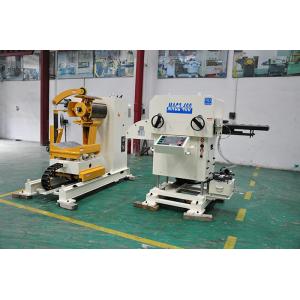

Add to Cart
The servo feeder adopts the combination of high-tech force distance
and position control, servo motor and its driving power, and is
equipped with high-speed calculation and precise control. It has a
good man-machine interface and completely shakes off the
traditional power transmission, pressure transmission and A new
type of feeding device that mechanically adjusts the feed length.
It can be matched with high-speed large-step feeding of punching
machine, and the feeding is accurate and reliable. It can also
cooperate with various working methods to improve the flexibility
of the machine, simplify the operation steps and greatly improve
the production efficiency.
First, the servo feeder adjustment test example:
1. Start the correcting machine or material holder and slowly
release the material. The servo feeder adjusts the position of the two stopper wheels according to the
width of the material, so as not to hinder the operation of the
material.
2. Relax the cylinder on the platform, put the material between the
upper and lower rollers, put down the cylinder to press the
material, adjust the air source pressure gauge to avoid the
material is not tight and slip, resulting in inaccurate feeding.
When the thickness of the material changes, it must be readjusted.
.
3. After setting the feeding length, look at the actual situation,
and set the feeding speed accordingly. The method of setting is
described in detail in the previous section.
4. After the relevant parameters of the feeding are set, the actual
feeding length is not the same as the set value due to the number
of the divisor. Therefore, in the manual mode, press the feeding
test, punching, stroke, stamping, and adjusting the feeding. The
actual length.
5. The adjustment of the feeding start is adjusted by the rotating
cam of the punching machine. The so-called feeding start signal is to start at which angle of
the punching crankshaft.
Specification:
| Model | MAC2-400 | MAC2-500 | MAC2-600 | MAC2-800 | ||
| Stock Width(mm) | 50-400 | 50-500 | 50-600 | 50-800 | ||
| Stock Thickness(mm) | 0.3~3.2 | 0.3-3.2 | 0.3-3.2 | -3.2 | ||
| Max.Coil Weight(kg) | 3000 | 3000 | 3000 | 5000 | 5000 | 7000 |
| Max.Coil O.D.(mm) | 1200 | 1200 | 1200 | |||
| Coil I.D.(mm) | 8 | 8 | 508 | 508 | ||
| Feed Length(mm) | ~500* | ~500* | ~500* | ~500* | ||
| Max. Line Speed(m/min) | 16-24 | 16-24 | 16-24 | 16-24 | ||
| Work Roll Number(pieces) | upper 6 lower 5 | upper 6 lower 5 | upper 6 lower 5 | upper 6 lower 5 | ||
| Feed Roll Number(set) | 1 | 1 | 1 | 1 | ||
| Main Motor(kw) | AC2.9 | AC2.9 | AC4.4 | AC4.4 | ||
| Mandrel Expansion | hydraulic | hydraulic | hydraulic | hydraulic | ||
| Reel Motor(kw) | 1.5 | 1.5 | 1.5 | 2.2 | 2.2 | 3.7 |
| Power(V) | 3 Phase 220V/380V/50HZ | |||||
| Operating Air(Mpa) | 0.49 | 0.49 | 0.49 | 0.49 | ||
Straigtening performance:
| tock Thicknees (mm) | Stock Width (mm) | |||
| 0.3 | 400 | 500 | 600 | 800 |
| 0.4 | ||||
| 0.6 | ||||
| 0.8 | ||||
| 1.0 | ||||
| 1.2 | ||||
| 1.4 | ||||
| 1.6 | 470 | 470 | ||
| 1.8 | 400 | 400 | ||
| 2.0 | 360 | 360 | ||
| 2.3 | 300 | 300 | 300 | 300 |
| 2.5 | 230 | 230 | 230 | 230 |
| 2.8 | 150 | 150 | 150 | 150 |
| 3.2 | 110 | 110 | 110 | 110 |
*1:(Pneumatic):Option in case of pneumatic mandrel expansion is
provi
